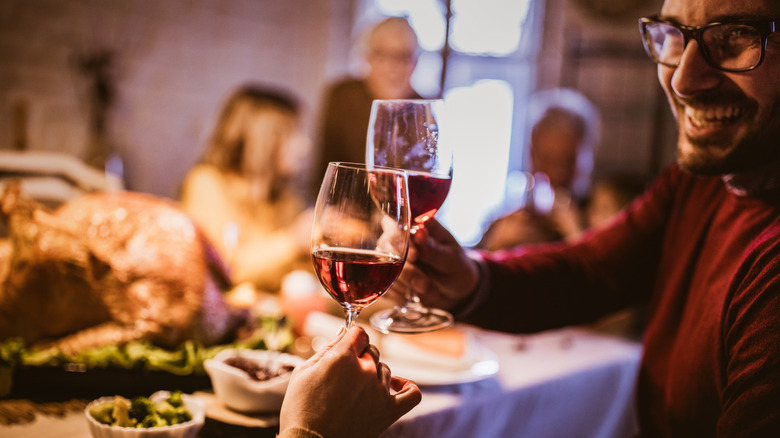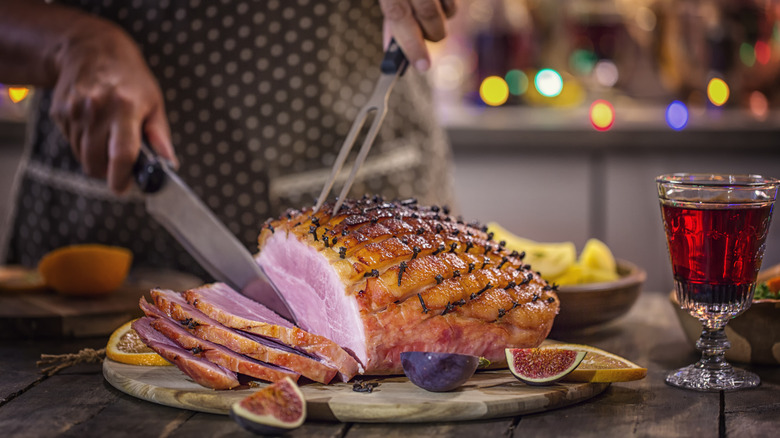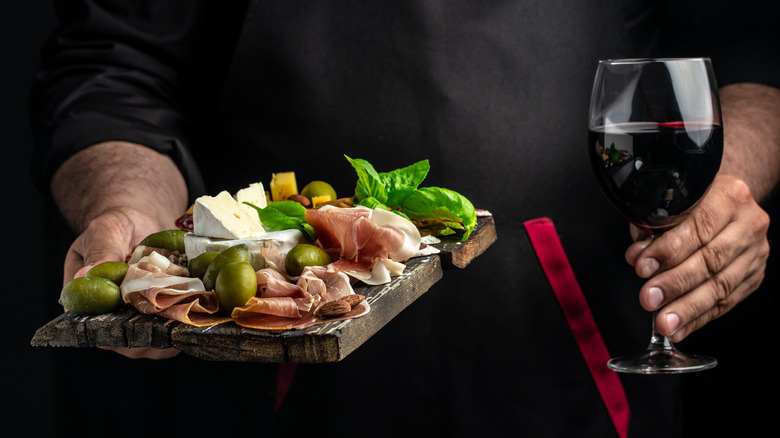The Best Wine To Pair With Your Thanksgiving Ham
For red wine lovers, the salty and smokey flavors of the Thanksgiving ham offer an excuse to introduce the rich, bold flavors of red wines to the dinner course. For master sommelier and national education manager at Treasury Wine Estates, Gillian Ballance, a bold cabernet sauvignon is just what your savory holiday ham needs to spark a sophisticated conversation on your tastebuds. And fortunately for Chowhound readers, the master sommelier shared wine suggestions with our editors.
Ballance advises, "For a rich, savory ham with bold flavors, pair it with an equally bold cabernet sauvignon." Her wines of choice on the big day include the 2020 Beaulieu Vineyard Georges de Latour private reserve cabernet sauvignon or the 2020 Beaulieu Vineyard Napa Valley cabernet sauvignon.
In the former case, you get the black cherry notes you expect from an elegant cabernet and complements of wild violet, black plum, bittersweet chocolate, and hints of vanilla and caramel from the French oak barrel. It adds a rich umami flavor to the meal, complementing your ham nicely. In the latter case, Bing cherry, red raspberries, and currants, as well as infusions of acai, blackberry, dark plum, and a bit of black pepper to spice things up, fuse together to give you a wine with a mouthfeel that isn't intimidated by the stoutness of ham.
How to choose your own Thanksgiving wine
Weight, flavor intensity, and flavor characteristics are the three primary factors in choosing a wine to go with your ham (or any food, really). Weight and flavor intensity go hand in hand, with the lightest wines, like Italian Prosecco, pairing up with fish and seafood, like scallops, and the darkest wines, such as Petite Sirah, complementing red meats, such as a New York strip or a ribeye steak. On this scale, ham comes after seafood and poultry and lands just before beef and venison, though ham leans more toward beef and venison than the fish or poultry side.
The wine you choose should reflect this scale, though that's not the only determining factor here. How ham is cooked plays a big role in flavor intensity and, therefore, wine choice. In other words, whether a ham is honey mustard glazed, smoked, dry-cured — or if you use the top tips to further improve your ham – the result will influence which wines taste best in this combo. Here's what all of these factors might look like when taken together. Smoked ham and deeply colored rosé would work well together, as would pinot noir and your favorite Turkey Day pork dish. However, it's also okay to experiment a bit or even go with a lighter-colored wine, like Riesling, if you're trying to choose a wine that would go with both ham and turkey, for example.
Why full-bodied wines are the way to go
Based on the recipe, Ham's relatively heavy weight and range of flavors put it squarely into the category of foods you'd pair with a full-bodied wine. You have a lot of wines to choose from in this category. Cabernet sauvignon, like Master Sommelier Gillian Ballance recommended, is one of them, though it isn't the only one. Syrah and malbec count among them, and if you are among the really adventurous food-and-drink types, you'll want to put Nero D'Avola on your list. It has a licorice-flavored kick that makes for some interesting flavor juxtapositions with some ham recipes. Or if you're partial to fruity wines, you might also consider shiraz, merlot, and Valpolicella.
Full-bodied wines contain 13.5% alcohol or higher and an admirable — read heavier – mouthfeel. In these wines, you'll also find dark, rich fruit flavors, like cherry or black currant, in addition to the taste infusions you'll get from the grapes. Any of these factors may also come into play as you're selecting dinner wines. For example, you may want to choose a medium-bodied wine like Chianti or Bordeaux because you'd like a wine with a lower alcohol percentage.
Finally, full-bodied wines also have another advantage come Thanksgiving. These wines complement the flavors of cheeses like Parmesan or cheddar cheese. And you know what that means. The wine you choose to drink while you nibble on the charcuterie board offerings will transition nicely into the ham course once the dinner bell rings.


